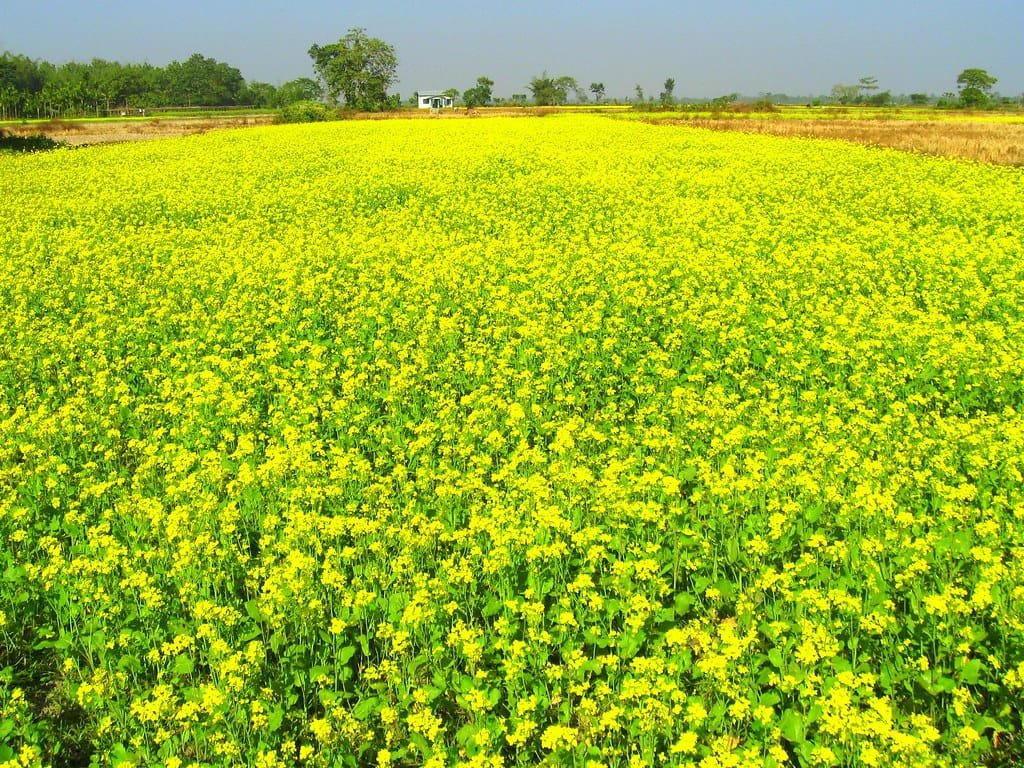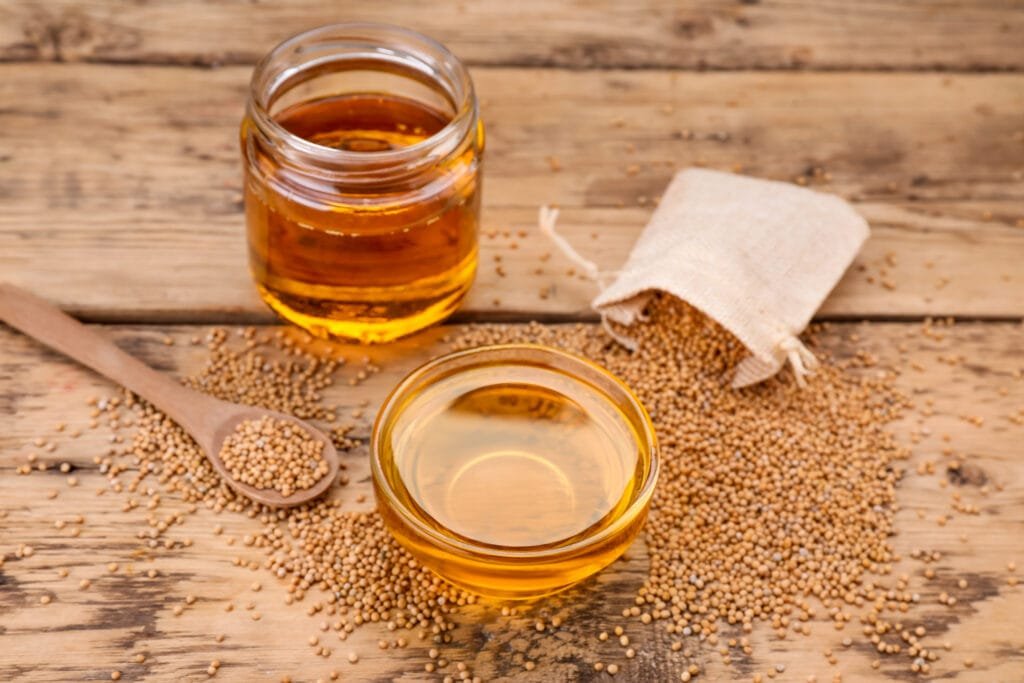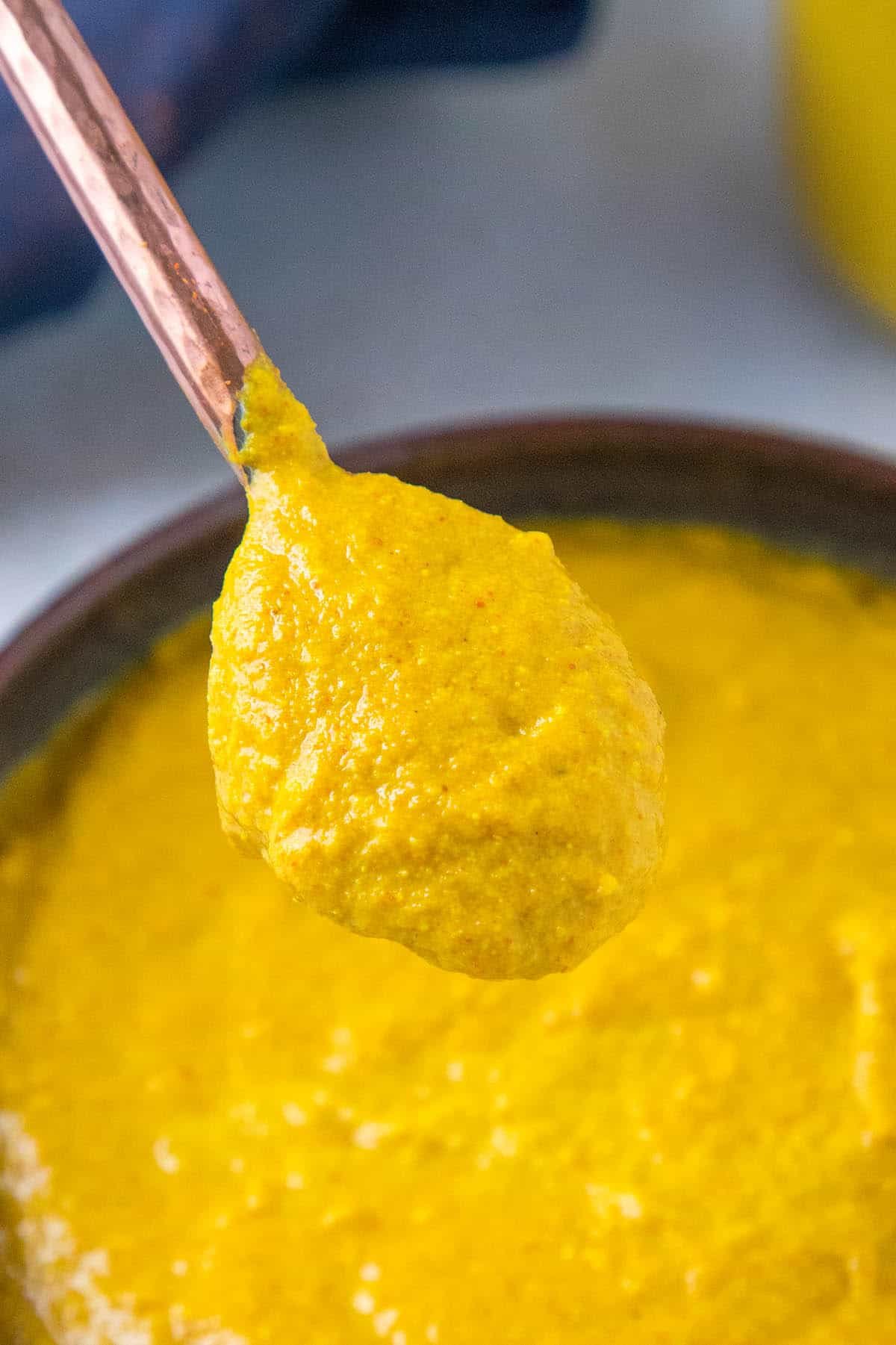
Summary of Contents
Introduction to Yellow Mustard
Yellow mustard (Sinapis alba), known for its vibrant yellow seeds and distinct tangy flavor, is one of the most versatile crops grown around the world, particularly in India. The mustard seed plays a crucial role in both culinary and medicinal practices and is a staple crop in Northeast India. Yellow mustard differs from its more pungent counterpart, black mustard (Brassica nigra), in flavor and use, but it remains an essential agricultural crop due to its numerous health benefits and economic importance.
Northeast India, known for its rich agricultural diversity, has embraced mustard farming for centuries. With the region’s organic farming potential and growing local and export demand, yellow mustard stands as a valuable asset in sustainable farming practices.
Natural Habitat and Varieties
Yellow mustard, a versatile crop, thrives in temperate climates with moderate rainfall. It is widely cultivated in plains and hilly regions alike. In Northeast India, particularly in the states of Assam, Manipur, and Meghalaya, yellow mustard farming is a significant agricultural activity during the winter season. This region’s temperate climate and diverse topography provide suitable conditions for mustard cultivation.
Natural Habitat
Yellow mustard is highly adaptable and thrives in a temperate climate with moderate rainfall. It is widely cultivated in plains and hilly regions alike. In Northeast India, particularly in the states of Assam, Manipur, and Meghalaya, mustard farming is a significant agricultural activity during the winter season.
Family and Genus
- Family: Brassicaceae
- Genus: Brassica
Yellow mustard belongs to the Brassicaceae family, the same family as cabbage, broccoli, and kale. The plant is known for its bright yellow flowers and small round seeds, which are used both for oil production and culinary purposes.
Varieties of Mustard
There are three main varieties of mustard, each with distinct characteristics:
- Yellow Mustard (Sinapis alba): Mild and slightly tangy, commonly used in sauces, dressings, and pickles.
- Brown Mustard (Brassica juncea): Stronger in flavor, often used in Indian cooking and mustard oil production.
- Black Mustard (Brassica nigra): Known for its sharp, pungent flavor, often used in traditional Indian dishes and Ayurvedic medicine.

History and Tradition in Northeast India
The cultivation of yellow mustard in Northeast India dates back centuries, with its exact origins shrouded in history. However, it is believed that mustard seeds were introduced to the region through trade routes or by early settlers. The adaptability of mustard to the region’s climate and soil conditions made it a valuable addition to the agricultural landscape.
- Climatic Adaptation: Mustard is well-suited to the cool winters and moderate temperatures of Northeast India. Its ability to thrive in a variety of soil types, including the region’s often hilly terrain, has further facilitated its cultivation.
- Traditional Farming Practices: Indigenous communities in Northeast India have employed traditional farming methods to cultivate mustard, passing down knowledge and techniques through generations.
Cultural Significance
Yellow mustard has deep cultural significance in Northeast India. It is used in various religious rituals and ceremonies, symbolizing purity and prosperity. The mustard plant itself is often considered sacred and is associated with deities in local folklore.
- Religious Rituals: Mustard seeds are used in various religious ceremonies and rituals, symbolizing purity and prosperity.
- Traditional Medicine: Mustard oil is used in traditional medicine for massage, skincare, and to relieve congestion.
- Kitchen Staple: Mustard oil is a staple ingredient in Northeast Indian cuisine, used for cooking and as a condiment.
- Cultural Identity: Mustard cultivation and its use in traditional practices have become an integral part of the region’s cultural identity.
- Symbolism: The mustard plant itself is often considered sacred and associated with deities in local folklore.
Health Benefits of Yellow Mustard
Yellow mustard seeds are packed with health-promoting compounds and nutrients that make them valuable for both culinary and therapeutic uses.

Rich in Antioxidants
Yellow mustard seeds contain powerful antioxidants like selenium and magnesium, which help protect the body from oxidative stress and inflammation. This makes mustard seeds beneficial for preventing chronic diseases, including heart disease and cancer.
- Selenium and Magnesium: Mustard seeds are a good source of selenium and magnesium, two essential minerals with antioxidant properties.
- Oxidative Stress Protection: These antioxidants help protect cells from damage caused by free radicals, reducing the risk of chronic diseases like heart disease, cancer, and premature aging.
Supports Digestive Health
Mustard seeds are rich in dietary fiber, aiding digestion and promoting healthy gut bacteria. They help regulate bowel movements, making them an ideal food for improving digestive health.
- Dietary Fiber: Mustard seeds are a good source of dietary fiber, which promotes healthy digestion, prevents constipation, and supports a balanced gut microbiome.
- Improved Nutrient Absorption: A healthy digestive system is essential for proper nutrient absorption, ensuring that your body gets the most out of the food you consume.
Anti-inflammatory Properties
Yellow mustard has strong anti-inflammatory properties due to its omega-3 fatty acids and glucosinolates. It can help reduce joint pain, alleviate symptoms of arthritis, and promote overall mobility.
- Omega-3 Fatty Acids: Mustard seeds contain omega-3 fatty acids, which have anti-inflammatory properties.
- Glucosinolates: These compounds are also known for their anti-inflammatory effects, helping to reduce inflammation in the body.
- Joint Pain Relief: Mustard can help alleviate joint pain and discomfort associated with inflammatory conditions like arthritis.
Boosts Metabolism and Weight Loss
Yellow mustard seeds are known to help boost metabolism, making them beneficial for weight management. They also contain isothiocyanates, compounds that promote fat burning and may reduce the risk of obesity.
- Metabolism Boost: Mustard seeds are believed to help boost metabolism, which can aid in weight management and calorie burning.
- Isothiocyanates: These compounds found in mustard seeds have been shown to promote fat burning and may reduce the risk of obesity.
Ideal Growing Conditions for Yellow Mustard
The successful cultivation of yellow mustard depends on the climate, soil conditions, and growing techniques used in farming.

Climate
- Cool Temperatures: Yellow mustard thrives in cooler temperatures, typically ranging from 10°C to 25°C.
- Winter Crop: It is commonly grown as a Rabi crop, sown in the winter season (October to November) and harvested in February or March.
- Northeast India’s Climate: The region’s cool winters and moderate temperatures provide ideal growing conditions for yellow mustard.
Soil Conditions and Terrain
- Well-Drained Soil: Yellow mustard prefers well-drained, loamy soils rich in organic matter.
- Soil pH: A slightly acidic to neutral pH (6.0 to 7.5) is optimal for plant growth and nutrient uptake.
- Hill Terrain: The hilly terrain of Northeast India offers excellent drainage, preventing waterlogging and promoting healthy root development.
Sunlight, Water, and Drainage
- Adequate Sunlight: Yellow mustard plants require at least 6-8 hours of sunlight per day for optimal growth and development.
- Moderate Rainfall: While the plant is relatively drought-tolerant, it requires moderate rainfall during the early stages of growth.
- Proper Drainage: Good drainage is essential to prevent waterlogging and fungal infections, which can harm the plants.
Season to Plant and Time Required to Grow
- Best Planting Season: The onset of the winter season (October to November) is the ideal time to plant yellow mustard seeds.
- Maturation Time: Yellow mustard is a short-duration crop, typically maturing within 90 to 110 days.
Shelf Life
- Storage Conditions: When stored in cool, dry conditions, yellow mustard seeds can have a shelf life of 6 to 12 months.
- Airtight Containers: Storing the seeds in airtight containers can help prevent moisture buildup and maintain freshness.
Best Organic Farming Techniques for Yellow Mustard
As the demand for organic produce continues to rise, farmers in the states of Northeast India are increasingly adopting sustainable and organic farming practices for yellow mustard cultivation. These methods prioritize environmental sustainability, human health, and animal welfare.
- Organic Manure and Compost: Using compost derived from organic waste and organic manure helps enrich the soil with nutrients, improve soil structure, and enhance water retention.
- Green Manures: Planting cover crops like cowpea or other legumes between mustard crops can help improve soil fertility by fixing nitrogen.
- Biofertilizers: Biofertilizers containing beneficial microorganisms can enhance nutrient uptake and promote soil health.
- Natural Pest Control: Using neem oil, garlic extract, or other natural pest control methods can help manage pests and diseases without relying on harmful chemicals.
- Mulching: Mulching with organic materials like leaves or straw can help retain soil moisture, suppress weeds, and regulate soil temperature.
- Cereals: Rotating yellow mustard with cereals like wheat or maize can help diversify crop rotations and reduce the risk of pest and disease buildup.
- Legumes: Intercropping yellow mustard with legumes like cowpea or pigeon pea can enhance soil fertility by fixing nitrogen.
By adopting organic farming practices, farmers in Northeast India can produce high-quality, organic yellow mustard while contributing to a more sustainable and resilient agricultural system.
Economic Impact of Yellow Mustard
Yellow mustard farming is economically significant, both locally and internationally, contributing to income generation for farmers and providing opportunities in the mustard oil and value-added product markets.

Market Dynamics
- Growing Domestic Demand: The local market for yellow mustard in Northeast India is expanding due to increasing consumer awareness of its culinary and medicinal uses.
- Emerging Export Markets: There is growing interest in exporting yellow mustard seeds and mustard oil to international markets, particularly in countries with a demand for Indian spices and condiments.
Investment and Profitability
- Initial Investment: Cultivating yellow mustard on 1 acre of land typically requires an initial investment of ₹15,000-₹20,000, covering costs such as seeds, organic fertilizers, and labor.
- High Return on Investment: Yellow mustard farming can be a profitable venture due to its relatively low input costs and high yield potential.
- Yield: A well-maintained mustard farm can yield around 700-900 kg per acre, providing a substantial income for farmers.
Employment Opportunities
- Job Creation: The yellow mustard industry provides employment opportunities for thousands of farmers, laborers, and workers in processing plants and distribution networks.
- Rural Livelihoods: The industry contributes significantly to the economic development of rural communities in Northeast India, providing a stable source of income.
Local Demand and Export Market
- Export Potential: India is a major exporter of mustard seeds and mustard oil, with significant export potential to countries like Bangladesh, Nepal, and the Middle East.
- Strong Local Demand: Mustard oil is a kitchen staple in Northeast Indian households, ensuring a steady local market for yellow mustard seeds.
Challenges in Growing Yellow Mustard
Despite its adaptability, yellow mustard cultivation in Northeast India faces several challenges. One of the primary concerns is the unpredictable nature of the monsoon, which can lead to waterlogging or drought, affecting crop yields. Additionally, yellow mustard is susceptible to pests and diseases, such as aphids, flea beetles, and fungal infections. Farmers often rely on traditional pest control methods, but these may not always be effective against persistent infestations. Furthermore, limited access to markets and fluctuating prices can pose challenges for farmers, making it difficult to ensure a stable income from yellow mustard cultivation.
Pest and Disease Control
- Aphids and Flea Beetles: These insects can infest mustard plants, causing damage to leaves and reducing yields.
- Fungal Diseases: White rust and powdery mildew are common fungal diseases that can affect mustard plants, leading to reduced growth and productivity.
- Organic Pest Control: Organic farmers may face challenges in finding effective, natural solutions to combat pests and diseases without resorting to synthetic chemicals.
Climate Vulnerability
- Heavy Rainfall: Excessive rainfall can lead to waterlogging, which can damage mustard plants and reduce yields.
- Drought: Prolonged dry periods can also negatively impact mustard growth and development.
- Unpredictable Monsoon: The unpredictable nature of the monsoon in Northeast India can pose challenges for farmers in terms of planning and managing their crops.
Market Access
- Post-Harvest Losses: Inadequate storage facilities can contribute to post-harvest losses, reducing the overall value of the produce.
- Infrastructure Constraints: Limited access to proper roads, storage facilities, and transportation can hinder the ability of small-scale farmers to reach larger markets.
- Reduced Profitability: Difficulty in accessing wider markets can lead to lower prices and reduced profitability for farmers.
Addressing these challenges requires a multifaceted approach, including the development of effective pest and disease management strategies, investments in infrastructure, and support for small-scale farmers. By overcoming these obstacles, the yellow mustard industry in Northeast India can continue to thrive and contribute to the region’s economic development.
The Versatility of Yellow Mustard
Yellow mustard is a versatile ingredient with a wide range of culinary and therapeutic applications. Its versatility and demand have made it a valuable agricultural commodity in many regions, including Northeast India.

Culinary Applications
- Mustard Sauce: Yellow mustard seeds are ground and mixed with vinegar, sugar, and spices to create the popular condiment, mustard sauce.
- Salad Dressings: Mustard sauce is a key ingredient in many salad dressings, adding a tangy flavor and enhancing the overall taste.
- Pickles: Yellow mustard seeds are used to flavor pickles, giving them a characteristic pungent taste and preserving the vegetables.
- Indian Cuisine: Mustard seeds are an essential ingredient in Indian cuisine, often added to tadka (tempering) to enhance the flavor of curries, stews, and other dishes.
Therapeutic Uses
- Joint Pain Relief: Mustard oil, extracted from yellow mustard seeds, is used in Ayurvedic medicine for massage to relieve joint pain and muscle soreness.
- Skin Health: Mustard oil can also be used as a natural hair conditioner and skin moisturizer, promoting healthy hair and skin.
- Traditional Medicine: Mustard oil is believed to have warming and stimulating properties, and is used to treat various ailments such as colds, congestion, and digestive disorders.
Value-Added Products
- Mustard Oil: Yellow mustard oil is a versatile product with numerous culinary and medicinal applications, contributing to the high demand for mustard seeds.
- Mustard Flour: Mustard flour, made from ground mustard seeds, is used as a spice in various dishes and as a base for salad dressings and sauces.
- Mustard Paste: Mustard paste, often mixed with vinegar and other spices, is a popular condiment used worldwide.
- Mustard Powder: Mustard powder is a concentrated form of mustard seeds, used as a spice or seasoning in various dishes.
Conclusion
Yellow mustard farming in Northeast India presents both economic and cultural value. With growing local and international demand, this golden crop offers high profitability and employment opportunities for rural communities. By adopting organic farming techniques and addressing market challenges, farmers can harness the full potential of yellow mustard to contribute to sustainable agriculture and economic growth in the region.
To explore more about Northeast India’s agricultural wealth, check out our in-depth article on the Top 20 Crops in Northeast India and discover the hidden gems of this fertile land.
FAQ Section
Q: What is the difference between mustard and yellow mustard?
A: Yellow mustard (Sinapis alba) has a milder taste and is often used in sauces, while brown and black mustard have stronger flavors commonly used for mustard oil and pickling.
Q: Is yellow mustard farming profitable?
A: Yes, yellow mustard farming is highly profitable, with yields of 700-900 kg per acre and a market price of ₹40-₹50 per kg.
Q: When is yellow mustard season?
A: Yellow mustard is typically grown as a Rabi crop, sown between October and November and harvested by February to March.
Q: How long does it take to grow yellow mustard?
A: Yellow mustard takes about 90 to 110 days to mature.
Q: How much does a yellow mustard plant yield?
A: Yellow mustard plants can yield about 700-900 kg per acre.
Q: What are the types of mustard?
A: The three main types of mustard are yellow mustard (Sinapis alba), brown mustard (Brassica juncea), and black mustard (Brassica nigra).
Q: Which mustard variety is best?
A: The best variety depends on usage—yellow mustard is preferred for mild condiments, while brown mustard is often used for mustard oil production.
Q: What is mustard seed used for?
A: Mustard seeds are used for making mustard oil, condiments, sauces, pickles, and in medicinal applications like treating inflammation and joint pain.
